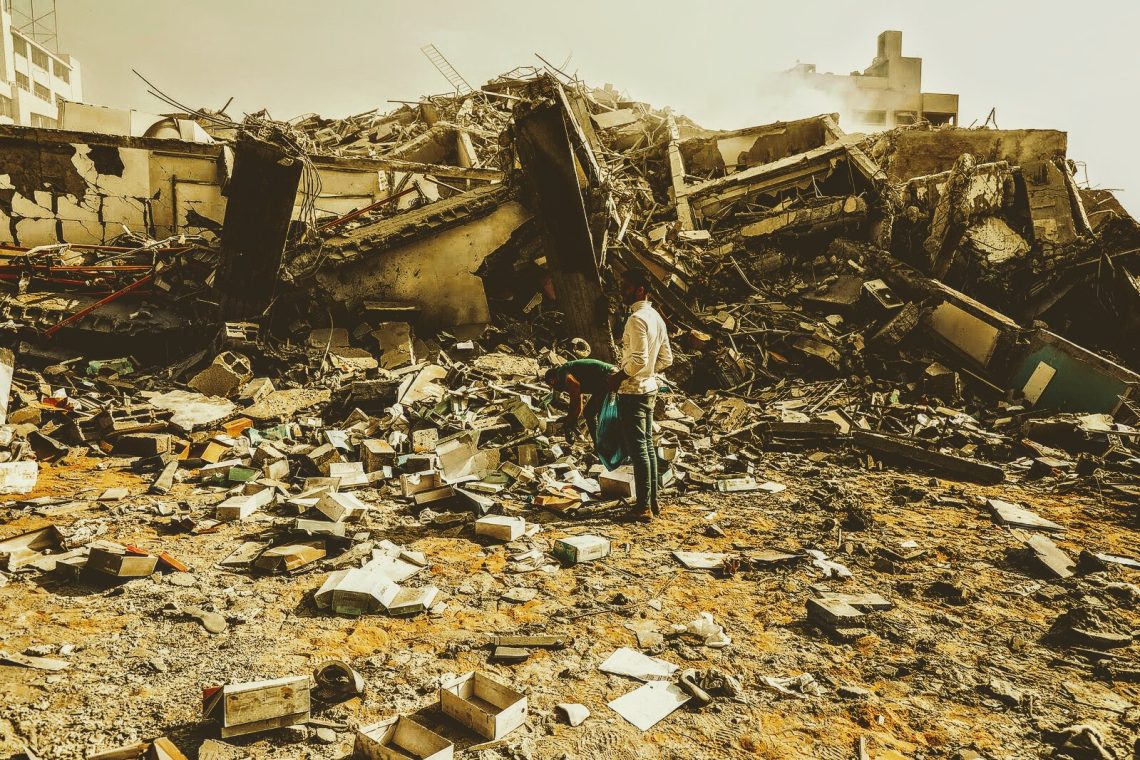The devastation for which the Israeli military has been responsible since 7 October 2023 raises urgent ethical, legal and political questions. Here, we focus on three puzzles which emerge from the way mainstream Western politics and media approach the question of Palestine in general and the war on Gaza in particular.
First, what explains this unprecedented violence by the Israeli government? Second, what explains the lack of concrete reactions from Arab states despite the importance of the Palestinian issue for their internal politics? Finally, what explains the insistence of Middle Eastern and Western governments on a ‘two-state solution’ that has failed for at least half a century?
Why does the Israeli government use devastating violence against Gaza?
First puzzle – the devastating use of violence by the current Israeli government. The most frequent answers found in Israeli and Western media and political rhetoric invoke Israel’s ‘right to defend itself’ and/or on neutralizing the threat to its security that comes from Palestinian armed groups.
This rhetoric takes for granted that the Israeli government’s response can achieve these goals. Closer scrutiny, however, suggests this is not the case. According to Israeli leadership, the violence is aimed at eliminating both Hamas and all armed resistance. Yet research shows that the massive use of violence against civilian populations does not reduce support for armed factions, rather it increases that support. Indeed, Palestinian public opinion polls taken before and after October 7 show as much.
The poll data also reveal another important aspect: since Hamas’ electoral victory in 2006, and with the temporary exception of the repeated armed campaigns conducted by Israel, popular support for Hamas has declined. So much so that the latest poll conducted by the Arab Barometer survey research project – which concluded on October 6 – showed that about three quarters of Gazans wanted a ‘two-state solution’ (i.e. peace) and did not trust Hamas.
This suggests two conclusions. First, when Israeli governments use massive violence against Hamas, they cannot expect to eliminate either support for Hamas itself or the demand for resistance among some of the Palestinian population, including armed resistance. Second, this data also suggests that the best strategy to ‘eliminate’ Hamas would have been simply for them to rule.
More plausible explanations for the use of violence by successive Israeli governments must be sought elsewhere. In particular, Israel’s political centre of gravity has shifted steadily towards a supremacist and maximalist far right ever since the Six-Day War of 1967 in which Israel conquered religiously symbolic places like the Western Wall and the Temple Mount/Haram El-Sharif in East Jerusalem. Faced with this shift, neither the USA, the EU, or Arab leaders have exerted sustained and significant pressure upon Israeli governments to find a real and lasting solution to the Palestinian question which addresses the conflict’s root causes.
In any case, Israel’s devastating violence has very little to do with eliminating armed resistance.
Why do Arab governments do so little?
Second puzzle – Arab governments have only issued timid condemnations of Israel’s actions and Western governments’ support. After all, the Palestinian question is very keenly felt among national public opinion in regional states, so one might expect clear and concrete reactions from these governments.
Indeed, there is no shortage of means available to these governments to take stronger and more effective measures. For example, these very states could have taken Israel to the International Court of Justice, rather than South Africa. Arab oil-producing countries could have boycotted Israel and the Western governments supporting it materially, as they did in 1973. This option would be particularly powerful since the Russo-Ukrainian war has very recently shown just how vulnerable Western governments are to threats to energy supplies.
Why, then, do Arab regimes not use tools available to them?
Beyond pro-Western preferences and alignments, which are relevant but incidental, the answer comes from these countries’ internal tensions and from the way the elites maintain their power.
Although these are highly diverse regimes and contexts, they have some common characteristics: 1) economic ‘reforms’ (austerity, cuts, privatisations, debt) over the past few decades have impoverished the middle and working classes; and 2) these regimes cannot compensate for the deterioration of economic conditions with political openings because these would produce contestation of the very economic reforms that enrich governing elites and which these are not prepared to reverse or slow down. In short, Arab regimes rely on mass demobilization to stay in power and fear mass mobilizations.
This strategy produces deep fractures: regimes are largely disliked by their populations, who do not trust them and/or are not satisfied with their living conditions. The resulting legitimacy deficit leads governments to resort to systematic political repression – further eroding their popular legitimacy – and to the search for external enemies to regain a modicum of credibility. Thus, support for the Palestinian cause and condemnation of Israeli and Western governments represent a useful propaganda tool.
However, Arab regimes are caught in a kind of balancing act: the strength of domestic public opinion means they cannot ignore the Palestine question entirely and indeed their legitimacy deficit tempts them to ‘use’ it, but their strategy of rule means they cannot fully exploit that public sentiment lest they risk their own positions. After all, the groups involved in Egypt’s 2011 revolution, for example, began their mobilization with government-authorised demonstrations in support of the Second Intifada in Palestine (2000-2001) and against the invasion of Iraq (2003) which regimes were attempting to use precisely to bolster their domestic legitimacy.
In short, the timid condemnations of Israel after 7 October are rooted in the attempt to strike a balance between harmful silence and destabilizing excess mobilization. Arab regimes’ gambit, however, leaves unresolved – and therefore further worsens – both their underlying internal tensions and the question of Palestine itself.
Why insist on a failed peace formula?
Third puzzle – like Arab governments and Israel itself, Western governments continue to propose strategies for ‘peace plans’ which on any rational, evidence-based consideration are doomed to fail. It’s worth noticing that since at least the late Egyptian president Anwar Sadat’s Camp David agreement for Palestine in 1979, ‘peace processes’ always have the same three-phase structure. In the first phase the fighting stops, resulting in a ‘negative peace, i.e. an absence of violence. The second phase should build trust between the parties, facilitating a gradual handover of power to Palestinian institutions. The final phase should consolidate peace by addressing negotiations on the underlying causes of conflict, or at least the most difficult ones to negotiate: borders between the two states, the status of East Jerusalem, Palestinian refugees and their ‘right of return’, water, sovereignty, etc.
This final phase should resolve the root causes of the conflict, making possible a long-term ‘positive peace’. Actual peace processes, however, have always failed in analogous ways: during the second, transitional phase violent ‘spoilers’ intervene which political leaders are unwilling and/or unable to control, and the peace process collapses in a spiral of violence and recriminations.
Why, then, have governments insisted on this failed formula for decades now? Perhaps not resolving the conflict is the point.
Instead of looking at the intentions proclaimed by the parties involved, consider the effects of such peace processes focusing on ‘negative peace’ and then failing. One such effect is that attempts to address the roots of conflict are at least temporarily set aside. As such, ‘positive peace’, in which the causes of conflict are resolved, is not only not achieved, but the very structure of such peace processes avoids having to deal with the causes of the conflict.
This allows those who pursue them to publicly claim they are seeking peace, but also to effectively ignore the underlying problems – which would require major compromises on the Israeli side and consequent international pressure in this sense and tensions with Israel and the USA, since successive Israeli governments have sought less to negotiate and compromise and more to change ‘facts on the ground’ –, knowing that sooner or later either delaying tactics or extremists will derail the process, forcing it to start all over again.
Such peace processes are in a way neither ‘negative’ nor ‘positive’, but palliative, in the sense that they are virtually certain not to be able to cure the underlying ‘disease’.
Not unlike their Arab counterparts, Western governments pursue processes of ‘negative peace’ – knowing full well these are palliative – to avoid being seen to do too little, to avoid their public opinion to press them for too much action.
Yet, as the extreme levels of violence seen in the current war on Gaza prove, hitting the palliative sweet spot only aggravates the conflict’s underlying causes.








